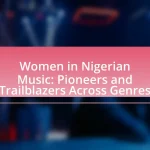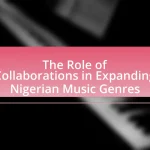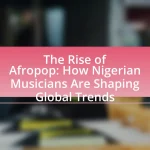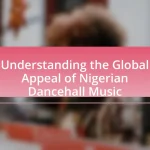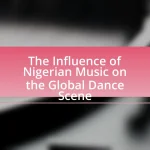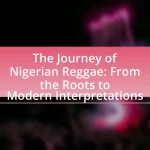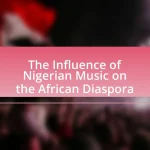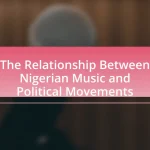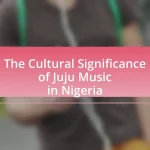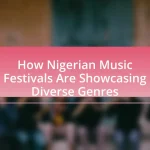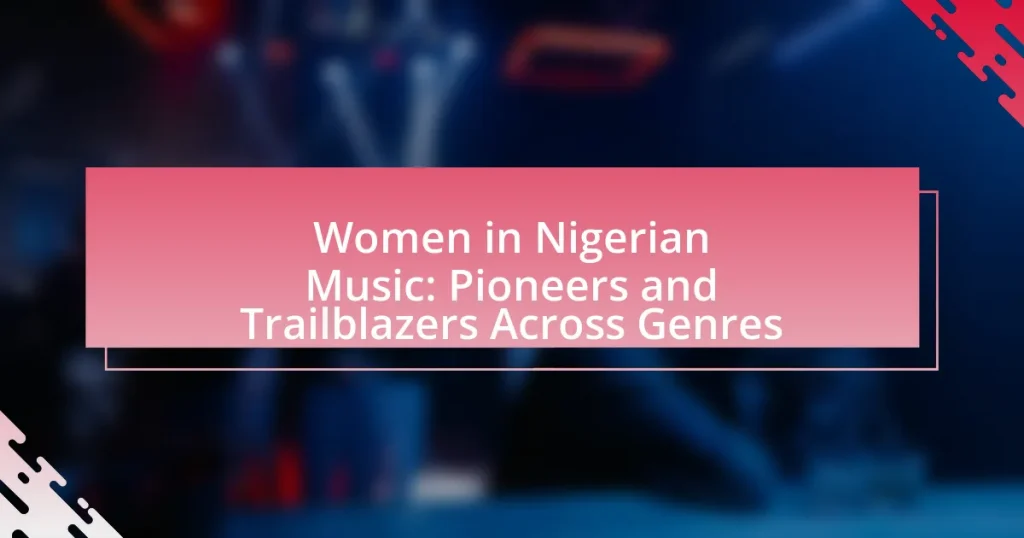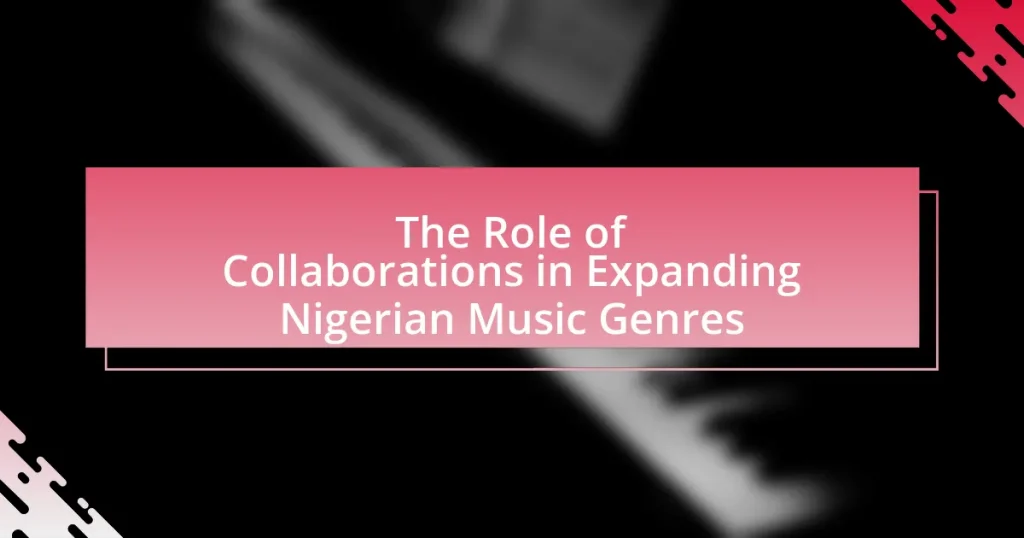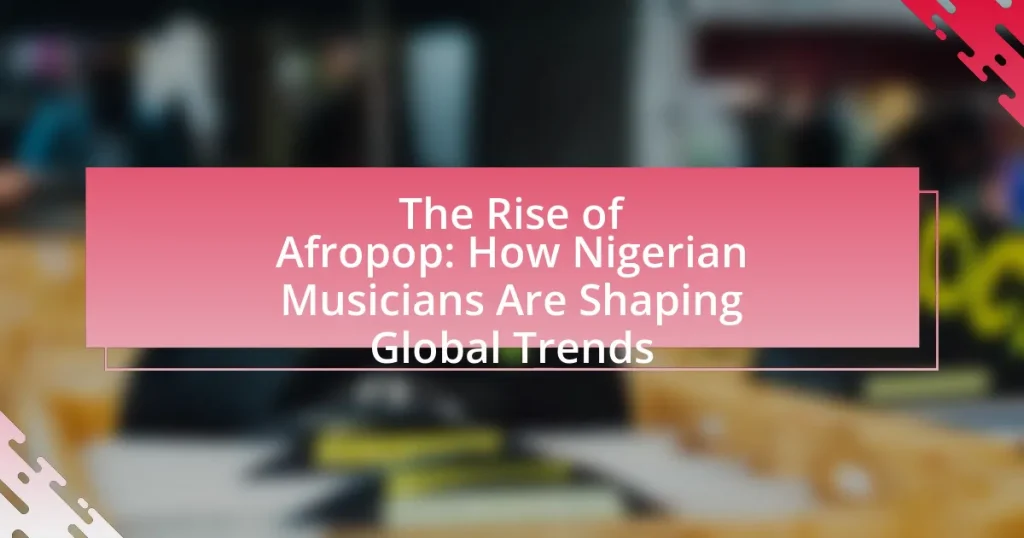Afrobeat is a music genre that originated in Nigeria, combining traditional African rhythms with jazz, funk, and highlife, and was pioneered by Fela Kuti in the late 1960s. The genre serves as a platform for political expression, addressing issues such as corruption and human rights abuses, and has evolved significantly since its inception. Contemporary artists like Burna Boy and Wizkid have expanded Afrobeat’s global reach by incorporating modern musical elements and technology while maintaining its cultural roots. This article explores the historical significance of Afrobeat, its musical characteristics, the influence of Nigeria’s political landscape, and the challenges faced by artists today, as well as the genre’s future trends and global impact.

What is Afrobeat and its Historical Significance?
Afrobeat is a music genre that combines traditional African rhythms, jazz, funk, and highlife, pioneered by Nigerian musician Fela Kuti in the late 1960s. Its historical significance lies in its role as a form of political expression and social commentary, addressing issues such as corruption, colonialism, and human rights abuses in Nigeria. Fela Kuti’s Afrobeat not only influenced the global music scene but also inspired subsequent generations of artists, making it a vital cultural movement that continues to resonate in contemporary Nigerian music.
How did Fela Kuti shape the Afrobeat genre?
Fela Kuti shaped the Afrobeat genre by blending traditional African music with jazz, funk, and highlife, creating a unique sound characterized by complex rhythms and politically charged lyrics. His innovative use of instrumentation, particularly the incorporation of horns and percussion, established a distinct musical style that emphasized groove and improvisation. Kuti’s lyrics often addressed social and political issues in Nigeria, making Afrobeat not just a musical genre but also a platform for activism. His influential albums, such as “Zombie” and “Expensive Shit,” solidified his role as a pioneer of Afrobeat, inspiring countless artists and contributing to the genre’s global recognition.
What musical elements define Fela Kuti’s Afrobeat style?
Fela Kuti’s Afrobeat style is defined by a fusion of traditional African rhythms, jazz, funk, and highlife music. This genre features complex polyrhythms, extended instrumental sections, and a strong emphasis on brass instruments, particularly saxophones and trumpets. Kuti’s compositions often include intricate guitar riffs and a prominent bass line, creating a layered sound that is both rhythmic and melodic. The use of call-and-response vocals, often addressing social and political issues, further characterizes Afrobeat. Kuti’s innovative approach to music, blending these elements, has made Afrobeat a significant genre in global music history.
How did Fela Kuti’s political activism influence his music?
Fela Kuti’s political activism profoundly influenced his music by integrating social and political commentary into his lyrics and performances. His songs often addressed issues such as government corruption, police brutality, and the struggles of the Nigerian people, making his music a platform for resistance and awareness. For instance, tracks like “Zombie” criticized the Nigerian military, while “Sorrow Tears and Blood” highlighted the impact of political oppression. This fusion of activism and music not only defined the Afrobeat genre but also inspired subsequent generations of artists to use their platforms for social change, solidifying Kuti’s legacy as a pivotal figure in both music and political discourse.
What cultural and social contexts contributed to the rise of Afrobeat?
The rise of Afrobeat was significantly influenced by Nigeria’s sociopolitical landscape and cultural heritage during the late 20th century. The genre emerged in the context of post-colonial Nigeria, where Fela Kuti, its pioneer, used music as a form of political expression against military dictatorship and social injustice. The cultural fusion of traditional African rhythms with jazz, funk, and highlife created a unique sound that resonated with the struggles and aspirations of the Nigerian populace. Additionally, the 1970s saw a growing awareness of African identity and pride, which Afrobeat encapsulated, making it a powerful vehicle for social commentary and cultural affirmation. The genre’s popularity was further fueled by the global interest in African music and the diaspora’s connection to their roots, solidifying Afrobeat’s place in both local and international music scenes.
How did Nigeria’s political landscape affect the development of Afrobeat?
Nigeria’s political landscape significantly influenced the development of Afrobeat by providing a backdrop of social unrest and governmental oppression that Fela Kuti and other artists responded to through their music. The military regimes and corruption prevalent in Nigeria during the 1970s and 1980s fueled a sense of resistance among musicians, leading them to use Afrobeat as a platform for political commentary and activism. For instance, Fela Kuti’s lyrics often criticized the government and addressed issues such as human rights abuses, which resonated with the public’s frustrations. This environment not only shaped the themes of Afrobeat but also helped it gain popularity as a form of protest music, ultimately solidifying its place in Nigerian culture and influencing subsequent generations of artists.
What role did traditional African music play in shaping Afrobeat?
Traditional African music significantly influenced the development of Afrobeat by providing foundational rhythms, instruments, and cultural themes. Afrobeat, pioneered by Fela Kuti, integrates traditional African musical elements such as polyrhythms, call-and-response patterns, and the use of indigenous instruments like the talking drum and shekere. These elements create a distinct sound that reflects African heritage while addressing contemporary social and political issues. The incorporation of traditional music not only enriches Afrobeat’s complexity but also connects it to the broader African cultural narrative, making it a powerful vehicle for expression and resistance.
How has Afrobeat evolved since Fela Kuti’s era?
Afrobeat has evolved significantly since Fela Kuti’s era, transitioning from a politically charged genre to a more diverse and commercially viable sound. Contemporary artists like Burna Boy and Wizkid have incorporated elements of pop, hip-hop, and electronic music, broadening the genre’s appeal globally. This evolution is evidenced by the international success of albums like Burna Boy’s “African Giant,” which won a Grammy Award, showcasing Afrobeat’s ability to resonate with a wider audience while still retaining its African roots.
What are the key characteristics of contemporary Afrobeat artists?
Contemporary Afrobeat artists are characterized by a fusion of traditional African rhythms with modern musical elements, including jazz, funk, and hip-hop. This genre often features complex polyrhythms, vibrant horn sections, and socially conscious lyrics that address political and cultural issues. Artists like Burna Boy and Wizkid exemplify this blend, incorporating global influences while maintaining African roots. The use of digital production techniques and collaborations with international artists further enhances their sound, making it accessible to a wider audience. This evolution reflects the genre’s adaptability and relevance in today’s music scene.
How do modern artists incorporate technology into Afrobeat?
Modern artists incorporate technology into Afrobeat by utilizing digital production tools, software for sound manipulation, and social media platforms for distribution and engagement. These artists often use software like Ableton Live and FL Studio to create complex rhythms and layers that enhance traditional Afrobeat sounds. Additionally, they leverage social media to reach global audiences, promoting their music and connecting with fans, which has expanded the genre’s reach beyond its origins. The integration of technology not only modernizes the sound but also allows for innovative collaborations across genres, exemplified by artists like Burna Boy and Wizkid, who blend Afrobeat with elements of hip-hop and electronic music.
What influences from other genres can be seen in today’s Afrobeat music?
Today’s Afrobeat music is significantly influenced by genres such as hip-hop, dancehall, R&B, and electronic music. The incorporation of hip-hop elements is evident in the rhythmic patterns and lyrical styles, with artists like Burna Boy and Wizkid blending rap verses into their songs. Dancehall influences manifest through the use of upbeat tempos and syncopated rhythms, which can be heard in tracks by artists like Tiwa Savage. R&B contributes to the melodic structures and vocal delivery, enhancing emotional expression in Afrobeat. Additionally, electronic music has introduced new production techniques and soundscapes, allowing for a modern twist on traditional Afrobeat sounds. These genre fusions reflect the dynamic nature of Afrobeat and its ability to evolve while maintaining its cultural roots.
Who are the prominent contemporary Nigerian artists in the Afrobeat scene?
Prominent contemporary Nigerian artists in the Afrobeat scene include Burna Boy, Wizkid, and Davido. Burna Boy, known for his Grammy-winning album “Twice as Tall,” blends Afrobeat with dancehall and reggae influences. Wizkid gained international acclaim with his collaboration on Drake’s “One Dance” and his album “Made in Lagos.” Davido, recognized for hits like “Fall” and “If,” has significantly contributed to the global popularity of Afrobeat. These artists exemplify the genre’s evolution while maintaining its core elements.
What contributions have artists like Burna Boy and Wizkid made to Afrobeat?
Burna Boy and Wizkid have significantly contributed to the global recognition and evolution of Afrobeat by blending traditional African rhythms with contemporary genres like hip-hop and dancehall. Burna Boy’s album “African Giant,” which received a Grammy nomination, showcases this fusion and has helped elevate Afrobeat on international platforms. Similarly, Wizkid’s collaboration with international artists, such as Drake on the hit “One Dance,” has brought Afrobeat to mainstream audiences, further popularizing the genre. Their innovative approaches and international collaborations have not only expanded the reach of Afrobeat but also influenced a new generation of artists within the genre.
How do these artists maintain the essence of Afrobeat while innovating?
Artists maintain the essence of Afrobeat while innovating by blending traditional rhythms and instrumentation with contemporary genres and technology. They incorporate classic Afrobeat elements, such as polyrhythmic drumming and horn sections, while integrating influences from hip-hop, R&B, and electronic music. For instance, artists like Burna Boy and Wizkid have successfully fused Afrobeat with dancehall and trap, creating a modern sound that resonates globally. This approach not only honors the foundational work of pioneers like Fela Kuti but also expands the genre’s reach, as evidenced by Burna Boy’s Grammy win for his album “Twice as Tall,” which showcases both traditional Afrobeat and modern influences.
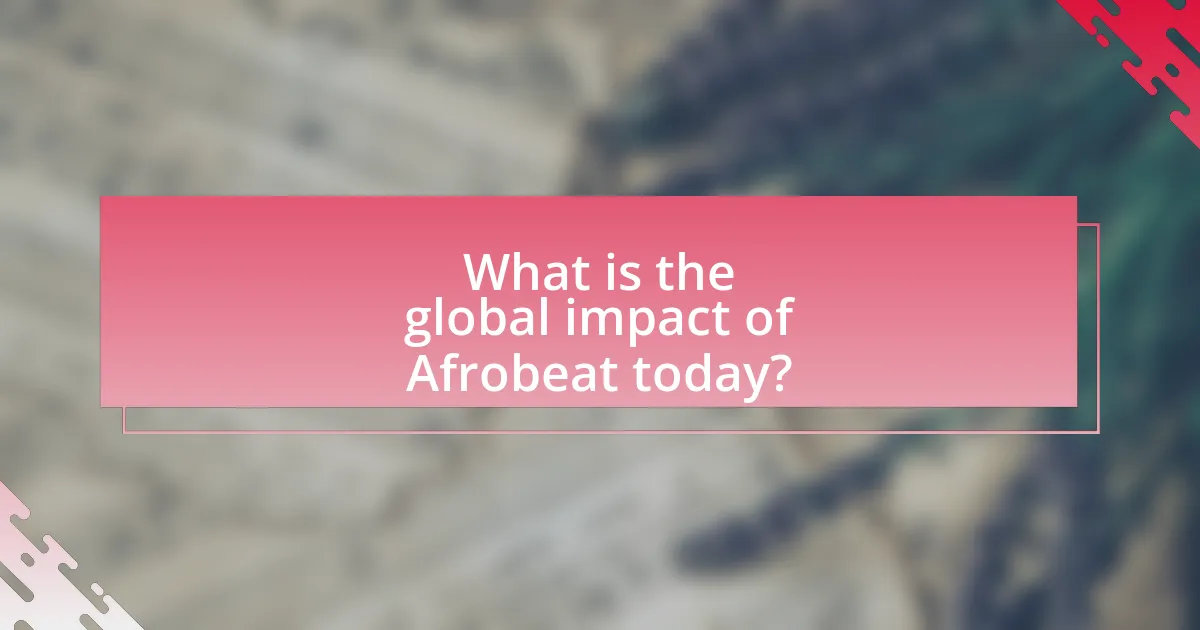
What is the global impact of Afrobeat today?
Afrobeat today has a significant global impact, influencing music genres, cultural exchanges, and social movements worldwide. The genre has gained international recognition, with artists like Burna Boy and Wizkid achieving chart success in markets such as the United States and Europe, exemplified by Burna Boy’s Grammy win for Best World Music Album in 2020. Additionally, Afrobeat’s fusion of traditional African rhythms with jazz, funk, and highlife has inspired a diverse range of musicians globally, leading to collaborations across genres and cultures. This cross-pollination has not only expanded the reach of Afrobeat but also fostered a greater appreciation for African music and culture, as seen in the growing popularity of Afrobeat dance classes and festivals worldwide.
How has Afrobeat influenced music outside of Nigeria?
Afrobeat has significantly influenced music outside of Nigeria by shaping genres such as hip-hop, jazz, and electronic music. Artists like Erykah Badu and The Roots have incorporated Afrobeat rhythms and instrumentation into their work, demonstrating its impact on contemporary music. Additionally, the global rise of artists like Burna Boy and Wizkid has brought Afrobeat to international audiences, leading to collaborations with mainstream artists such as Beyoncé and Drake, further solidifying its influence. The genre’s fusion of traditional African sounds with funk and jazz elements has inspired musicians worldwide, creating a cross-cultural exchange that continues to evolve.
What collaborations between Afrobeat artists and international musicians have emerged?
Collaborations between Afrobeat artists and international musicians have significantly increased, with notable examples including Burna Boy’s partnership with Ed Sheeran on the track “Own It” and Wizkid’s collaboration with Drake on “One Dance.” These collaborations highlight the global appeal of Afrobeat, as evidenced by Burna Boy’s Grammy win for Best Global Music Album in 2021 and Wizkid’s recognition at the Billboard Music Awards. Additionally, Tems collaborated with Future on “Wait for U,” further showcasing the genre’s influence in mainstream music.
How is Afrobeat received in different cultural contexts worldwide?
Afrobeat is received with varying degrees of enthusiasm and cultural integration across different global contexts. In Africa, particularly Nigeria, Afrobeat is celebrated as a powerful expression of social and political commentary, rooted in the legacy of Fela Kuti, who used the genre to address issues like corruption and inequality. In Europe and North America, Afrobeat has gained popularity in music festivals and clubs, often blending with genres like jazz and hip-hop, which reflects a growing appreciation for its rhythmic complexity and cultural significance. For instance, artists like Burna Boy and Wizkid have achieved international acclaim, showcasing Afrobeat’s ability to resonate with diverse audiences. This global reception is evidenced by the genre’s increasing presence on streaming platforms and collaborations with mainstream artists, indicating a broader acceptance and integration into popular music culture.
What challenges do contemporary Afrobeat artists face in the music industry?
Contemporary Afrobeat artists face significant challenges in the music industry, including limited access to global distribution channels and financial resources. Many artists struggle to secure funding for production and marketing, which hampers their ability to reach wider audiences. Additionally, the competition from established genres and artists can overshadow emerging Afrobeat talents, making it difficult for them to gain recognition. The lack of adequate infrastructure for live performances in certain regions further complicates their ability to connect with fans. According to a 2021 report by the International Federation of the Phonographic Industry, African artists, including those in the Afrobeat genre, receive only a small percentage of global music revenues, highlighting the economic barriers they face.
How do issues of commercialization affect the authenticity of Afrobeat?
Commercialization significantly impacts the authenticity of Afrobeat by prioritizing marketability over cultural expression. As Afrobeat has gained global popularity, artists often adapt their music to fit commercial trends, which can dilute the genre’s original messages and social critiques that were central to Fela Kuti’s vision. For instance, the shift towards more mainstream sounds and collaborations with international pop artists can lead to a loss of the genre’s traditional elements, such as its political commentary and unique instrumentation. This trend is evidenced by the increasing use of electronic production techniques and the incorporation of Western pop influences, which can overshadow the genre’s roots in African rhythms and social activism.
What strategies can artists use to navigate the global music landscape?
Artists can navigate the global music landscape by leveraging digital platforms, collaborating internationally, and engaging with diverse audiences. Digital platforms such as Spotify and YouTube provide artists with access to a global audience, allowing them to distribute their music widely without traditional gatekeepers. Collaborating with artists from different cultures can enhance creativity and broaden appeal, as seen in the rise of Afrobeat artists who fuse genres and styles. Engaging with diverse audiences through social media and live performances helps artists build a loyal fan base and adapt their music to various cultural contexts. These strategies are supported by the increasing globalization of music consumption, where diverse sounds are more readily embraced, as evidenced by the growing popularity of Afrobeat worldwide.
What are the future trends for Afrobeat and its artists?
Future trends for Afrobeat and its artists include increased global collaboration, genre fusion, and the rise of digital platforms for distribution. Afrobeat artists are likely to collaborate more with international musicians, expanding their reach and influence, as seen with Burna Boy’s partnerships with artists like Ed Sheeran and Beyoncé. Additionally, the blending of Afrobeat with other genres, such as hip-hop and electronic music, is expected to continue, attracting diverse audiences. The growth of streaming services and social media will further enable Afrobeat artists to connect with fans worldwide, as evidenced by the significant increase in Afrobeat streams on platforms like Spotify and Apple Music.
How might technology continue to shape the evolution of Afrobeat?
Technology will continue to shape the evolution of Afrobeat by enhancing music production, distribution, and collaboration. Digital audio workstations and software allow artists to experiment with diverse sounds and styles, leading to innovative Afrobeat fusions. Streaming platforms like Spotify and Apple Music enable wider global reach, allowing Afrobeat artists to connect with international audiences and collaborate with musicians from various genres. Additionally, social media platforms facilitate real-time engagement and promotion, helping artists build their brands and fan bases. The integration of artificial intelligence in music creation also opens new avenues for experimentation, further evolving the genre.
What role will social media play in promoting Afrobeat artists?
Social media will play a crucial role in promoting Afrobeat artists by providing a platform for widespread visibility and engagement. This digital landscape allows artists to share their music, connect with fans, and collaborate with other musicians globally, significantly enhancing their reach. For instance, platforms like Instagram and TikTok have been instrumental in the viral success of songs, with Afrobeat tracks often trending due to user-generated content and challenges. Additionally, data from the International Federation of the Phonographic Industry indicates that social media is a primary source for music discovery among younger audiences, further validating its importance in the promotion of Afrobeat artists.
What can aspiring Afrobeat artists learn from the genre’s evolution?
Aspiring Afrobeat artists can learn the importance of blending traditional African rhythms with contemporary sounds from the genre’s evolution. The evolution of Afrobeat, initiated by Fela Kuti in the 1960s, showcased how incorporating jazz, funk, and highlife elements can create a unique musical identity. This fusion not only broadened the genre’s appeal but also allowed artists to address social and political issues through their music, as seen in Kuti’s work. Additionally, the rise of modern Nigerian artists like Burna Boy and Wizkid demonstrates the significance of global collaboration and digital platforms in reaching wider audiences, emphasizing that innovation and adaptability are crucial for success in the evolving music landscape.
